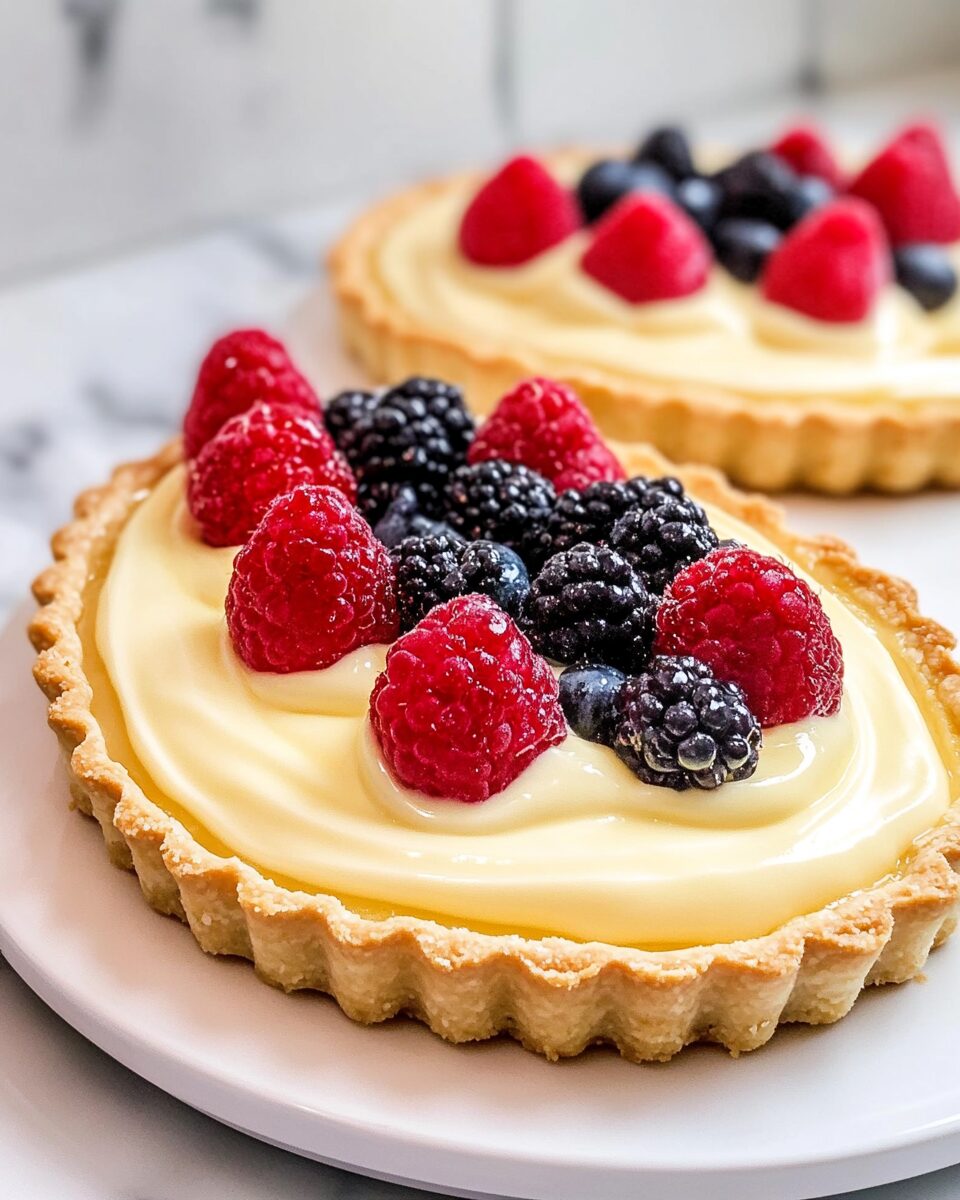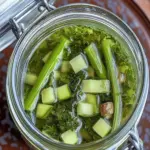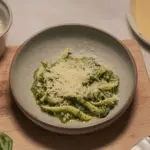The French Lemon Cream Tart is a celebration of contrast—tangy and bright lemon filling nestled in a rich, buttery sweet crust. This classic French dessert is a delight for both citrus lovers and pastry fans alike. The lemon cream is luxuriously smooth, with the perfect balance of tart and sweet that dances on your tongue with every bite. Perfect for spring brunches, afternoon tea, or a special dinner party, this tart offers both elegance and flavor in one stunning presentation. Whether you’re new to tarts or a seasoned baker, the process is as satisfying as the result—especially when you slice into that silky lemon layer sitting atop a golden, crisp crust.
Full recipe:
Ingredients:
For the Pâte Sucrée (Sweet Tart Dough):
-
1 1/4 cups (156g) all-purpose flour
-
1/4 cup (50g) granulated sugar
-
1/4 teaspoon salt
-
1/2 cup (113g) unsalted butter, cold and cubed
-
1 large egg yolk
-
1–2 tablespoons cold water (if needed)
For the Lemon Cream Filling:
-
1 cup (200g) granulated sugar
-
Zest of 3 lemons
-
4 large eggs
-
3/4 cup (180ml) fresh lemon juice (about 3–4 lemons)
-
Pinch of salt
-
1 cup (226g) unsalted butter, softened and cut into tablespoons
For Garnish (Optional):
-
Powdered sugar
-
Fresh berries or candied lemon slices
Directions:
-
Prepare the Tart Dough:
In a food processor, pulse together flour, sugar, and salt. Add cold butter and pulse until the mixture resembles coarse crumbs. Add egg yolk and pulse until dough begins to come together. If too dry, add 1–2 teaspoons cold water. -
Turn dough onto a lightly floured surface and knead briefly. Flatten into a disc, wrap in plastic wrap, and chill for at least 1 hour.
-
Preheat oven to 375°F (190°C). Roll out dough to fit a 9-inch tart pan. Press into the pan and trim excess. Prick bottom with a fork.
-
Line with parchment paper and fill with pie weights or beans. Bake for 15 minutes, then remove weights and bake for another 10–12 minutes until golden. Let cool completely.
-
Make the Lemon Cream:
In a heatproof bowl, combine sugar and lemon zest. Rub together with fingers to release oils. Add eggs, lemon juice, and salt. -
Place bowl over a pan of simmering water (double boiler) and whisk constantly for 10–12 minutes until thickened and reaches 180°F (82°C).
-
Remove from heat and strain through a fine mesh sieve into a blender. Let cool for a couple of minutes.
-
With the blender running, add butter one piece at a time until smooth and creamy. Chill for 30 minutes before using.
-
Spoon the lemon cream into the cooled tart shell and smooth the top. Chill for at least 1 hour before serving. Garnish with powdered sugar, berries, or candied lemon if desired.
Prep Time: 25 minutes | Cooking Time: 25 minutes | Total Time: 1 hour 50 minutes (including chilling)
Kcal: 410 kcal | Servings: 8 slices
Everything You Need to Know About the French Lemon Cream Tart: A Zesty Classic with a Buttery Twist
The French Lemon Cream Tart, also known in France as Tarte au Citron, is one of those desserts that looks effortlessly elegant while delivering bold, fresh flavors in every bite. At first glance, it may seem like a simple lemon tart, but don’t be fooled—this version features a silky lemon cream that sets it apart from the standard lemon curd tart you might be used to. With its delicately crisp pâte sucrée crust and intensely smooth, citrusy filling, this tart is the epitome of refined indulgence. Whether you’re a casual baker or an experienced home cook looking to elevate your dessert game, this tart deserves a spot in your rotation. Let’s explore the origin, benefits, expert techniques, and why this tart earns rave reviews across the baking world.
The French Roots: A Classic Dessert with a Culinary Pedigree
The French Lemon Cream Tart comes from a long tradition of European citrus desserts, with roots tracing back to patisseries in Paris and the southern regions of France where lemon trees thrive. Lemons—especially the fragrant, floral Menton variety—are staples in French Riviera kitchens. French pastry chefs perfected the balance of sweet and tart by developing this creamier, more luxurious take on the lemon tart. Unlike traditional lemon pies or American-style lemon bars, the French approach to lemon tarts involves gentle cooking and emulsification—techniques that yield a filling as smooth as mousse and rich with the flavor of fresh citrus zest. The result is a dessert that feels upscale and light all at once.
Why It’s the Best: Flavor, Texture & Versatility
So what makes this lemon tart truly stand out? Three simple reasons:
Unparalleled Texture
- The texture of this lemon cream is a game changer. Instead of a gelatinous or overly set lemon curd, the cream in this tart is smooth, buttery, and melt-in-your-mouth soft. This comes from a unique technique of cooking the eggs, lemon juice, and sugar over a bain-marie (double boiler), followed by blending in softened butter. It’s more like a French pastry cream infused with citrus than a traditional curd.
A Crust Worth Savoring
- The crust—pâte sucrée—is a sweet tart dough made with butter, sugar, egg yolk, and flour. It’s more tender and cookie-like than American pie crusts. Its subtle sweetness perfectly complements the tangy lemon filling and offers a satisfying contrast in texture: crisp yet delicate.
Sophistication with Simplicity
- Despite its refined taste and texture, this tart is very achievable at home. The ingredients are straightforward, and the techniques, once mastered, offer you a gateway to more advanced French patisserie.
Tips from the Kitchen: Expert Advice for Success
If you’re making this tart for the first time, here are some essential tips to help you nail it:
Use Fresh Lemons Only
- Bottled lemon juice won’t cut it here. Use fresh lemons, and don’t skip the zest—it’s what gives the cream its aromatic depth. Meyer lemons work beautifully if you want a less acidic version.
Chill Everything
- This recipe relies on cold butter for the crust and soft (but not melted) butter for the cream. Keeping ingredients at the right temperatures ensures a flaky crust and a properly emulsified cream.
Don’t Rush the Double Boiler
- This step is crucial. Cook the lemon mixture gently until it thickens to about the consistency of hollandaise sauce. Rushing this over high heat can scramble the eggs, ruining the texture.
Strain the Cream
- Even if your mixture looks smooth, always strain it before blending. This step guarantees a perfectly velvety finish, free of zest bits or any accidental curdled egg.
Serving Suggestions: The Perfect Ending to Any Meal
This tart is incredibly versatile. Serve it at a summer picnic, a holiday dinner, or as a bright ending to a rich meal. Pair it with:
- A dollop of fresh whipped cream
- A handful of fresh raspberries or blueberries
- A drizzle of raspberry coulis
- A light dusting of powdered sugar
It also pairs beautifully with sparkling wine or a cup of Earl Grey tea, making it a lovely choice for brunches or afternoon gatherings.
Variations and Add-Ons
Once you’ve mastered the classic version, try experimenting with these delicious twists:
- Lemon-Lavender Tart: Add 1/2 teaspoon of culinary lavender to the cream while it cooks, then strain out.
- Lemon-Basil Tart: Infuse the cream with basil leaves during cooking, then strain for a herbal citrus combo.
- Mixed Citrus Tart: Use a blend of lemon, lime, and orange juice for a more complex citrus flavor.
- Meringue Topping: Add a layer of Italian meringue on top and torch it for a French Lemon Meringue Tart.
Health and Nutrition Insights
While this tart is undeniably indulgent, it does come with a few surprising nutritional upsides:
- Lemon juice is high in Vitamin C, an antioxidant that supports your immune system and skin health.
- The butter, while rich, contributes to a high-quality fat source—when enjoyed in moderation, it adds satisfaction and satiety.
- Compared to other desserts, this tart has relatively few ingredients and no preservatives or artificial flavors, making it a cleaner indulgence than many store-bought pastries.
You can also make substitutions to suit your dietary needs:
- Use a gluten-free flour blend for the crust to make it gluten-free.
- Use dairy-free butter alternatives if you’re lactose intolerant or vegan (though texture may vary slightly).
- Adjust the sugar if you’re looking to reduce sweetness—lemon has a strong enough flavor to carry the dish even with lower sugar content.
Why Readers Love It
Don’t just take our word for it—this tart has become a go-to favorite for many food bloggers, pastry chefs, and home bakers. Here’s why:
- “The texture is out of this world—like a lemon cloud!”
- “It’s elegant enough for a dinner party, but easy enough for Sunday baking.”
- “My guests thought it came from a patisserie!”
This recipe consistently garners rave reviews for its balance, elegance, and the sheer joy it brings to anyone lucky enough to enjoy a slice.
Ingredient Sourcing Tips
- Butter: Use European-style butter for a richer flavor and higher fat content. Brands like Plugrá or Kerrygold work beautifully.
- Flour: All-purpose flour works great, but for even more delicate texture, try using pastry flour.
- Lemons: Organic lemons are ideal since you’re using the zest. Wash thoroughly before zesting.
Make-Ahead and Storage Notes
This tart is ideal for making ahead. In fact, chilling it for a few hours (or even overnight) allows the flavors to deepen and the texture to set properly.
Storage Tips:
- Refrigerate for up to 4 days in an airtight container.
- The crust can be made and frozen unbaked for up to 2 months.
- The lemon cream can be prepared a day ahead and stored in the fridge before assembling.
When to Serve It
Because of its light, zesty profile, this tart is perfect for:
- Spring and Summer Events: Garden parties, picnics, Mother’s Day
- Holiday Gatherings: A bright contrast to heavy winter desserts
- Celebrations: Birthdays, weddings, baby showers
- Everyday Treats: Because you deserve a little French magic
Conclusion
The French Lemon Cream Tart is more than just a dessert—it’s a culinary experience. It embodies the best of French pastry: precision, elegance, and deeply satisfying flavor. Whether you’re serving it to guests or treating yourself, it’s sure to impress. Its buttery crust, luxurious filling, and delicate citrus zing create a memorable combination that dances across the palate. It’s sophisticated without being fussy, indulgent yet refreshing—a perfect balance in every sense. Once you master this tart, you’ll not only have a stellar recipe in your repertoire—you’ll also understand key techniques of French patisserie that can be applied to countless other desserts.






